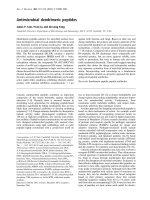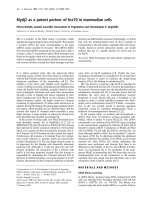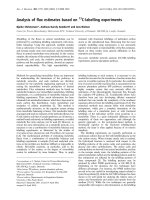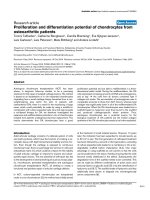Báo cáo y học: "Digital drug discovery" pot
Bạn đang xem bản rút gọn của tài liệu. Xem và tải ngay bản đầy đủ của tài liệu tại đây (54.74 KB, 3 trang )
Genome Biology 2005, 6:348
comment
reviews
reports
deposited research
interactions
information
refereed research
Meeting report
Digital drug discovery
Michael A Goldman
Address: Department of Biology, San Francisco State University, San Francisco, CA 94132-1722, USA. E-mail:
Published: 30 September 2005
Genome Biology 2005, 6:348 (doi:10.1186/gb-2005-6-10-348)
The electronic version of this article is the complete one and can be
found online at />© 2005 BioMed Central Ltd
A report of the Cambridge Healthtech Institute conference
‘Beyond Genome’, San Franciso, USA, 13-16 June 2005.
Fallout from the completion of the Human Genome Project
and the growing application of our knowledge to medicine
includes a blurring of the borders between academia and
industry. More than 1,000 individuals from universities, gov-
ernment agencies, financial, biotechnology and pharmaceuti-
cal companies - from established scientists and graduate
students to financiers - came together in June at the Cam-
bridge Healthtech Beyond Genome conference. This included
the 14th annual Bioinformatics and Genome Research
meeting, and this years’s specialist topics included RNA inter-
ference, systems biology, proteomics and genomic variation.
Expectations are high. What we are looking at, according to
Leroy Hood (Institute for Systems Biology, Seattle, USA) is
the “digitalizing of biology and medicine - a revolution
coming”. Hood’s long-term vision includes new platforms
for the analysis of the billions of data points about human
biology that we will acquire over the next ten years. These
data will be of different kinds, and must be integrated. His
institute’s database can handle more than a dozen different
types of data but, said Hood, “we will need a new math”.
Beginning with the analysis of model systems such as yeast
and sea urchin, Hood ultimately envisions a study of neuro-
biology that starts from stem cells and moves up to nervous
systems. Working with Eric Davidson (CalTech, Pasadena,
USA), Hood has modeled a network of 35 genes that control
early development in the sea urchin. On the medical front,
he emphasized the need to analyze blood serum proteins
efficiently as a means of diagnosing and staging disease.
Within ten years, he predicted, we will be able to measure
1,000-2,000 serum proteins efficiently enough for use in
routine diagnostics. Such analyses will need miniaturizing to
achieve the necessary throughput, and the Alliance for
Nanosystems Biology, which includes CalTech, the Institute
for Systems Biology and the University of California at Los
Angeles, is working on microfluidics, mixing pumps and
chambers comprising a nanolaboratory.
But how will we do this exciting new biology? Hood believes
that the interdisciplinary work required is difficult within
the traditional academic institution, and with the usual
mechanisms of funding and publication. The National Insti-
tutes of Health (NIH) roadmap for research in the 21st
century, published in 2003, clearly sees the importance of
novel interdisciplinary projects, but, said Hood, the grant
review panels have not caught up. The mainstream journals,
too, have been resistant, and dedicated journals for systems
biology are coming to the rescue.
Eugene Butcher (Stanford University, USA) believes that
systems biology is “ready to be applied to drug discovery”.
The application of genomics has led to large numbers of
potential targets for drug action, but Butcher thinks that
target-based drug discovery is failing us: he estimates that
no more than three, and sometimes fewer, innovative new
drugs are produced each year and that most new drugs
derive from previously existing drugs. He considers that a
more sensible approach would be to match promising drug
molecules to their cognate targets using computational
biology. Butcher’s systems approach to this uses the BioMAP
disease model, which emphasizes the subset of regulatory
networks involved in disease processes, and which is derived
from a limited number of protein measurements taken from
primary human cell cultures of various types. Starting with a
database of drug molecules and data on the metabolic
systems these drugs perturb, the analysis is automated and
reproducible, and the model can be queried in much the
same way as commonly used databases. Using BioMAP to
look for drug molecules that perturb inflammatory path-
ways, Butcher’s method detected most anti-inflammatory
drugs presently on the market, as well as an anticancer drug
that was later shown biochemically to affect inflammation.
The potential for using the systems approach to identify
novel applications for known, safe drugs is enormous and,
not surprisingly, the US Food and Drug Administration
(FDA) is interested. Compound screening using a cell-based
systems biology approach could shave 3 years and more than
$300 million off the cost of developing a new drug.
Building adequate computational models requires vast
quantities of data, and these data must be reliable and repro-
ducible. Microarray studies have been notoriously difficult to
evaluate. The FDA lists “sensitivity, specificity, reproducibil-
ity, robustness, reliability, accuracy, precision” as some of
the challenges in integrating microarray data into drug
development and medicine. Investigators at Harvard
Medical School and at the National Institute for Standards
and Technology (NIST, Gaithersburg, USA) are among those
trying to establish appropriate protocols. Zoltan Szallasi
(Harvard’s Children’s Hospital, Boston, USA) pointed out
the implications of using a single hybridization protocol for
the thousands of distinct probes that comprise a microarray,
resulting in widespread cross-hybridization. Szallasi cites
several causes for the observed inconsistencies, including
the use of incorrect probes, poor understanding of the
sequence dependence of ⌬G (Gibbs free energy change) values
of DNA-RNA hybridization, and the folding of labeled tran-
scripts. “How can we trust the fate of patients to microarray
measurements if we cannot reproduce the […] classification
with different microarray platforms?” he asked.
Marc Salit (NIST) sees NIST’s role in this area as developing
the tools needed to understand the performance of gene-
expression microarrays. Such tools are likely to include stan-
dards, reference data, measurement methods, statistical
methods, and thermodynamic models. The complete experi-
ment, from sample preparation through to data analysis and
interpretation, can be supported through a better under-
standing of the underlying measurement. Issues such as
RNA sample integrity, microarray scanner performance,
hybridization thermodynamics, and quantitative determina-
tion of measurement uncertainty will all contribute to that
better understanding. One approach currently in use is the
measurement of RNA degradation in samples, using fluores-
cence resonance energy transfer and PCR, to determine the
integrity of the transcripts for ‘housekeeping’ genes. The tra-
ditional approaches of metrology - the science of measure-
ment - will be applied to these problems to establish
microarray measurements of known quality. Salit considers
that the immediate goal is to enable users to understand the
quality and meaning of array data.
Computational biology is still not sufficiently powerful to
mimic every aspect of a biological system; for that, the cells
themselves may still be the best machines. Two interesting
approaches that were described at the meeting attempt to
model liver cells and cardiac myocytes in vitro. About two-
thirds of candidate drugs that fail do so because of toxicity or
problems in absorption, distribution, metabolism and excre-
tion, accounting for about one-fifth of the cost of drug devel-
opment, according to Anand Sivaraman (Massachusetts
Institute of Technology, Cambridge, USA). In an attempt to
make in vitro screening more efficient, his group is growing
liver cells in the channels of a microchip, with the flow of
culture medium mimicking blood flow in the liver. This three-
dimensional bioreactor more faithfully replicates the in vivo
complexity of the liver itself, resulting in an improved in vitro
model. Bioreactors have been used to detect the induction of
cytochrome P450, part of the liver’s system for metabolizing
drugs, by xenobiotic agents. While the ultimate goal of this
engineering might be to build or repair livers, its immediate
usefulness is in screening potential drug molecules for liver
toxicity and other key aspects of drug metabolism.
Effects on heart rhythm are among the most prominent and
deadly complications of drug treatment, accounting for
about half of the pharmaceuticals withdrawn from the
market. Simple cellular models for cardiac function have
been limited because adult cardiomyocytes tend to dediffer-
entiate rapidly in culture. Timothy Kamp (University of Wis-
consin, Madison, USA) described his team’s development of
human cardiac myocyte models. Non-human cell lines may
not provide an adequate model because the ion-channel pro-
teins are very variable from species to species. Kamp and
colleagues have induced human embryonic stem cells
(hESCs) to differentiate into cardiomyocytes, and have used
these cells to screen for drug toxicity and related properties.
Despite the restrictions on the use of hESCs in the US, the
WiCells from which Kamp prepared the cardiomyocytes
were approved for federally funded research under President
George W. Bush’s policy of August 2001. The hESC-derived
cardiomyocytes beat in culture, and display an action poten-
tial characteristic of embryonic, rather than adult, heart
cells. For example, elongation of the Q-T interval (which rep-
resents the total duration of electrical activity in the ventri-
cles in vivo) can be observed; this occurs as a drug
side-effect and resulted in the withdrawal of the allergy med-
ication Hismanal in 1999. The Madison-based company Cel-
lular Dynamics International, a spin-off from the University
of Wisconsin stem-cell group, is developing ESC technology
as a tool in pharmacological studies. But Kamp’s ultimate
goal is the use of stem cell-derived heart cells in direct thera-
peutic applications.
Gary Peltz (Roche, Palo Alto, USA) is exploiting quantitative
genetics in mice to understand and treat human disease. He
described his vision of extending today’s healthcare para-
digm of diagnosis and therapy to include predisposition
screening, targeted monitoring, and an emphasis on preven-
tive medicine. In an attempt to identify genes influencing
osteoporosis, Pelz has defined 58 chromosomal regions
influencing bone density and strength in mouse models. This
work led to the identification of 15-lipoxygenase encoded by
a gene on chromosome 11, which affects mesenchymal stem-
cell differentiation, as a potential target for therapeutic
drugs. To speed such work, Roche maintains an extensive
public database of single-nucleotide polymorphisms (SNPs)
348.2 Genome Biology 2005, Volume 6, Issue 10, Article 348 Goldman />Genome Biology 2005, 6:348
in mice [], and uses 19 commer-
cially available mouse strains, all of which have been haplo-
typed, enabling the co-occurrence of quantitative phenotypic
traits (traits determined by quantitative trait loci, QTLs) and
markers to be determined in days. This is extraordinarily
quick compared with a typical QTL analysis, which involves
animal breeding for several generations to give thousands of
F2 animals, and typically takes up more than ten scientist-
years per trait. Pelz and colleagues are next aiming at nar-
cotic addiction treatments, where they have already
identified polymorphisms in the 
2
-adrenergic receptor as
showing a strong correlation with pain tolerance in animals
undergoing narcotic withdrawal. The results suggest imme-
diately the possible application of 
2
-blocking agents to alle-
viate the symptoms.
There is general agreement that the pharmaceutical block-
busters of today will give way to medications tailored to
common genetic profiles. Russ Altman (Stanford University,
USA) called the genes that influence drug responses “phar-
macogenes”, and the study of such genes is widely recog-
nized under the banner of pharmacogenomics. Investigators
seek to relate genetic variation to differences in drug effec-
tiveness and safety. For example, the metabolism of 6-
mercaptopurine, a purine analog used to treat lymphoblastic
leukemia, is influenced by the genetically determined activity
of the enzyme thiopurine methyltransferase (TPMT). Altman
sees much promise in pharmacogenomics, but the science is
still in its infancy. Only limited data on genetic variation in
drug responses are available in the public domain, and geno-
type testing is still relatively expensive. Healthcare providers
may not be ready to understand and use the information. The
pharmaceutical industry, long accustomed to blockbuster
drugs, is not fully receptive to the idea of drug markets frag-
mented by the genetic stratification of patients. Altman’s lab-
oratory manages PharmGKB.org, a public database for
pharmacogenomics []. The site, used by
an estimated 25,000 people a month, includes genomics,
laboratory and clinical data, and links with Medline, the
Protein Data Bank, the SNP database (dbSNP), and
GenBank. Relevant pathways have been rendered by artists
as Illustrator files and are freely available.
While most speakers referred to personalized medicine,
Michael Liebman (Windber Institute and Walter Reed Army
Medical Center, Washington DC, USA) considers that the
“quality chasm in healthcare between bench and bedside” will
be closed only when we recognize “personalized disease”.
Invasive ductal carcinoma, for example, may actually repre-
sent 130 different diseases, and a disease is a process rather
than a single state. Phenotypic analysis to define the type of
ductal carcinoma can involve mammograms, ultrasound,
positron emission tomography (PET)/computer tomography
(CT) scans, and magnetic resonance imaging (MRI), in
addition to tumor staging, DNA sequencing, SNP analysis,
comparative genomic hybridization, loss-of-heterozygosity
analysis, gene expression and proteomic profiling. Liebman
maps disease phenotypes as a function of genetics, lifestyle,
and environment, and includes events like polio vaccination;
he is working on Bayesian networks for the staging and diag-
nosis of breast disease.
Michael Heller (University of California, San Diego, USA) is
looking forward to the $1,000 genome sequence - the day
when someone will be able to get his or her own personal
genome data, paid for by health insurance as an ordinary
preventive medical expense, on a DVD. Heller is a strong
believer in personalized medicine. With development costs
at a staggering $800 million for a single new drug, we are
“littered with failed drug corpses”. Reliable genotyping to
divide patients into smaller groups that could benefit from a
potential new drug (patient stratification) is essential. Heller
is the founder of Nanogen, in San Diego, a company dedi-
cated to the accurate and reliable use of microarrays for
genotyping. Collaborations with workers at the University of
Texas Medical School at Dallas have shown that some
sequences that are difficult to resolve by traditional methods
are accurately determined by Nanogen’s experimental
microarray platform. Heller thinks that the $1,000 genome
may depend on the development of new nanotechnologies,
such as nanophotonic switching devices using quantum dots
conjugated to DNA probes. The $1,000 genome will need
minimal handling of the material, should avoid labeling,
amplification and orientation procedures, and should ideally
take only hours to days to run. The NIH is currently allocat-
ing funds for technical developments in this field.
The application of genomics, bioinformatics and systems
biology in drug discovery and medicine holds tremendous
promise. Vast stores of microarray data and whole-genome
scans feed sophisticated digital models of human health and
disease. It is clear that we are on the cusp of a revolution in
healthcare, but we have yet to realize significant changes in
the clinic. We can anticipate more exciting developments
when Beyond Genome returns to San Francisco in 2006.
comment
reviews
reports
deposited research
interactions
information
refereed research
Genome Biology 2005, Volume 6, Issue 10, Article 348 Goldman 348.3
Genome Biology 2005, 6:348









